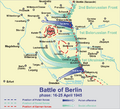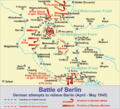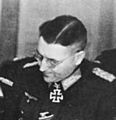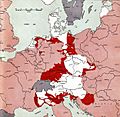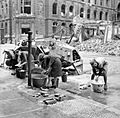Battle of Berlin facts for kids
Quick facts for kids Battle of Berlin |
|||||||
|---|---|---|---|---|---|---|---|
| Part of the Eastern Front of World War II | |||||||
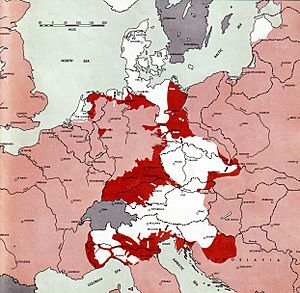 Front lines 1 May 1945. |
|||||||
|
|||||||
| Belligerents | |||||||
| Commanders and leaders | |||||||
|
|
|
||||||
| Strength | |||||||
| 2,500,000 soldiers, 6,250 armoured vehicles, 7,500 airplanes, 41,600 artillery guns. | 850,000 soldiers, 1,500 armoured vehicles, 3,500 airplanes, 9,300 artillery guns. | ||||||
| Casualties and losses | |||||||
| 81,116 killed, 280,281 injured. | 458,080 killed, 479,298 captured. | ||||||
The Battle of Berlin was the very last major battle of World War II in Europe. It took place in Berlin, the capital city of Germany, from April 16 to May 3, 1945. During this battle, the Red Army (from the Soviet Union) and Polish forces worked together. They successfully captured the city of Berlin from Nazi Germany. This victory was a huge step towards ending the war in Europe.
Contents
What Led to the Battle of Berlin?
The Soviet and Polish Advance
On January 12, 1945, Soviet and Polish armies began a big attack. They pushed forward until they reached the Oder River. This river is only about 60 kilometers (37 miles) east of Berlin. By 1945, the German army, called the Wehrmacht, was much weaker. They had fewer good soldiers and weapons compared to earlier in the war.
Hitler's Decision to Stay
Adolf Hitler, the leader of Nazi Germany, decided to stay in Berlin. His advisors told him it was safer to leave. But Hitler chose to remain in the city. He even heard news that the American President, Franklin D. Roosevelt, had died. Hitler hoped this might somehow save Berlin from being captured.
The Fight for Seelow Heights
A Strong German Defense
The main battle for Berlin started at a place called the Seelow Heights. These heights are about 17 kilometers (11 miles) west of the Oder River. They are also 45 kilometers (28 miles) east of Berlin. The German army had set up very strong defenses there.
The Attack Begins
On April 16, the Red Army and Polish Army launched their attack on Seelow Heights. Nearly 1,000,000 soldiers attacked. They had 20,000 artillery guns to help them. They were fighting against about 100,000 German soldiers. The Germans had 1,200 tanks. Even with so many fewer soldiers and tanks, the German defenders fought hard. They managed to hold the heights for four days.
Bombing Berlin's Center
On April 20, which was Hitler's birthday, the Allied forces started bombing the center of Berlin. They used rockets and artillery. The bombing continued without stopping until the city finally gave up.
Hitler's Realization
By April 22, Hitler knew that his army's plans had failed. He became very angry. He understood that the war was almost completely lost for Germany. One of his generals, Alfred Jodl, suggested a plan. He thought an army fighting the U.S. Army, led by Walther Wenck, could connect with the soldiers in Berlin. Hitler agreed to this idea. However, those troops were never able to reach the city.
Berlin Falls to the Allies
Hitler's Last Days
Hitler stayed in his underground bunker, called the Führerbunker, until his death. He knew it was almost impossible to escape. His soldiers also knew this and wanted to get out of the city. Since there was no hope of winning, Hitler gave orders for a breakout plan on April 28. But this plan did not go well. Only a few soldiers managed to get past the Soviet lines. On April 29, Hitler allowed another attempt to break out on May 1.
The Capture of the Reichstag
On April 30, the Red Army captured the Reichstag, a very important German government building. They were now only about 500 yards (457 meters) from Hitler's bunker. On this day, Hitler and several other leaders took their own lives.
The Final Surrender
On May 1, Helmuth Weidling, a German general, ordered his troops to try and break out. One group, called the Nordland Division, did escape. But they were caught outside Berlin. In the days that followed, the remaining armies of Nazi Germany began to surrender. This marked the end of World War II in Europe.
Interesting Facts About the Battle of Berlin
- The Battle of Berlin lasted for 22 days.
- At the start of the battle, there were around 850,000 German soldiers in and near Berlin.
- After the Battle of Berlin, about 20 million Germans were left without homes.
- The Soviet Army captured Berlin on May 2, 1945.
- Around 81,000 Soviet soldiers died, and about 458,000 German soldiers died.
- The Battle of Berlin was one of the most important battles of World War II. It led to the defeat of Nazi Germany and brought an end to the war in Europe.
Images for kids
-
April 1945: a member of the Volkssturm, the German home defence militia, armed with a Panzerschreck, outside Berlin
-
Volkssturm men armed with Panzerfausts
-
2nd Lt. William Robertson, US Army and Lt. Alexander Sylvashko, Red Army, shown in front of sign East Meets West symbolizing the historic meeting of the Soviet and American Armies, near Torgau, Germany.
-
A devastated street in the city centre just off the Unter den Linden, 3 July 1945
See also
 In Spanish: Batalla de Berlín para niños
In Spanish: Batalla de Berlín para niños



